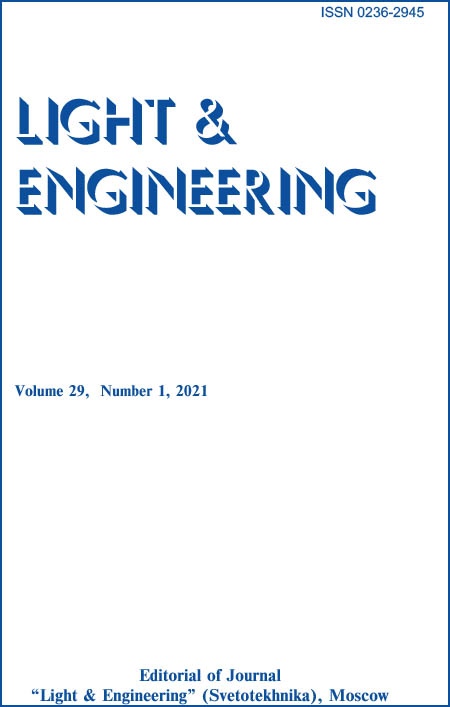Content

Light & Engineering 29 (1)
Volume 29Date of publication 02/27/2021
Pages 104–114
Abstract:
For the measurement of linear low-pressure UV lamps radiant flux the method proposed by the IUVA, which is based on the Keitz method, has become widely used. For deriving the equation that connects the irradiance generated by a lamp at a close distance and its radiant flux, the authors of the method presume that the lamp is the cylinder of equal radiance. According to our estimates, this assumption leads to the inaccuracy of 3 % to 5 % with respect to goniophotometric measurements. In this research, a general formula is derived that connects the irradiance generated by a linear emitter and its radiant flux. This formula does not impose restrictions on the radiant intensity curve in the longitudinal plane. The Keitz equation is its particularcase. To reduce the inaccuracy of the IUVA method, the angular distribution of the radiant intensity of the UV lamps is proposed to be approximated by a cosine polynomial. In order to find the coefficients of the polynomial,clarify the Keitz formula, as well as to estimate the inaccuracy of the refined and classical versions of this formula, the series of goniophotometric measurements of the DB15, DB18, DB30 lamps at various distances was carried out. It was found that at a scanning step Δθ = 5° the first 9 terms of the trigonometric expansion are sufficient to describe the radiant intensity curve with accuracy satisfactory for practical use. It was also shown that the Keitz method needs to be refined only on the basis of goniophotometric data obtained upon condition r / l ≥ 6 where r is the test distance, l is the lamp length. It was identified that in the case of a differentiated approach, the approximation of the low-pressure UV lamps radiant intensity curve by a cosine polynomial makes it possible to provide an inaccuracy of simplified methods that does not exceed 1 % in relation to the goniophotometric method. It is in dicated that in order to find a universal factor applicable for the entire range of linear low-pressure UV lamps, the development and the analysis of statistical data is required.
References:
1. Wasserman A.L. Measurement of the germicidal flux of UV mercury lamps of low pressure [Izmereniye bakteritsidnogo potoka UF rtutnykh lamp nizkogo davleniya] // Svetotekhnika, 2019, # 1, pp. 69–72. 2. Gershun A.A. Measure of the set of rays [Gershun A.A. Mera mnozhestva luchey / A.A. Gershun, Trudy GOI] // Proceedings of GOI, 1941, T. 14, No. 112–20, pp. 239–244. 3. Gershun A.A. Selected Works on Photometry and Lighting Engineering [Gershun A.A. Izbrannyye trudy po fotometrii i svetotekhnike: B-ka russkoy nauki. Matematika. Mekhanika. Fizika. Astronomiya] Library of Russian Science. Mathematics. Mechanics. Physics. Astronomy / Moscow: State. publishing house fiz.-matem. lit. Gostekhizdat, 1958, 548 pages. 4. GOST R8.760–2011. Measurement of energy and effective characteristics of ultraviolet radiation of bactericidal irradiators. Measurement Procedure: State system for ensuring the uniformity of measurements. Measurement of energy and the effective characteristics ultraviolet radiation germicidal irradiators. Procedure of measurements: national standard of the Russian Federation: ed. official .: introduced for the first time: introduced on 2013–01–01: State system for ensuring the uniformity of measurements / ed. Feder. tech agency regulation and metrology. – Moscow: Standartinform, 2014,7 p. 5. Kuzmenko M.E. Experimental researches of a discharge in vapors of mercury and inert gases and development of a powerful source of UV radiation: Candidate of physical and mathematical sciences dissertation: 01.04.08 / Moscow, 2001,142 p. 6. Leonid M. Vasilyak, Leonid A. Drozdov, Sergei V. Kostyuchenko, Nikolai N. Kudryavtsev, Denis A. Sobur, Dmitry V. Sokolov, and Shunkov Yuri E. A Method of UV Radiant Flux Measuring of LP Tubular Bactericidal Lamp// Light & Engineering, 2011, Vol. 19, #2, pp. 81–86. 7. Meshkov V.V. Lighting installations: Fundamentals of standardization, design and calculation: [Study guide] [Electronic resource] / Moscow, Leningrad: publishing house and type. Gosenergoizdata, 1947, 640 pages. 8. Rokhlin G.N. Discharge light sources / G.N. Rokhlin// M: Energoatomizdat, 1991,719 p. 9. Syromyasov A.O. Approximation of photometricdata by trigonometric polynomials of one variable / А.О. Syromyasov, S.V. Prytkov // Almanac of modern science and education, 2014, Vol. 84, No. 5–6, pp. 117–122. 10. Keitz H.A.E. Light calculations and measurement. An introduction to the system of quantities and units in light-technology and to photometry / H.A.E. Keitz. – Eindhoven: Philips’ Technical Library, 1955, 413 pages. 11. Method for measurement of the output of monochromatic (254 nm) low pressure UV lamps / O. Lawal at al. // IUVA News, 2017, Vol. 19, № 1. 12. Proposed method for measurement of the output of monochromatic (254 nm) low pressure UV lamps / O. Lawal at al. // IUVA News, 2008, Vol. 10, № 1. 13. SageMath Mathematical Software System – Sage [electronic medium]. – URL: https://www.sagemath.org/. 14. Sasges M. Ultraviolet Lamp Output Measurement: A Concise Derivation of the Keitz Equation / M. Sasges, J. Robinson, F. Daynouri // Ozone: Science & Engineering, 2012, Vol. 34, № 4, pp. 306–309. 15. Standard Method for Quantifying the Output of UV Lamps / M.R. Sasges [and other] // Proc. International Congress on Ozone and Ultraviolet Technologies, 2007. 16. Ultraviolet characterization of integrating spheres / P.-S. Shaw [and other] // Appl. Opt. – 2007, Vol. 46, № 22, pp. 5119–5128.
Keywords
- linear low-pressure UV lamp
- radiant flux
- Keitz equation
- goniophotometric measurements
- trigonometric approximation
- distribution curve of radiant intensity
Recommended articles
About Efficiency of the Ultraviolet Diodes Applied for Disinfection of Water L&E, Vol.31, No.3, 2023
The Influence Of The Led Luminaires Electrical Parameters On Their Correlated Colour Temperature During Operation Mode Light & Engineering Vol. 28, No. 5
Testbed for Studying the Efficiency of Plants Photosynthetic Irradiation Based on Measuring Carbon Dioxide Concentration in the Air L&E, Vol.30, No.3, 2022



